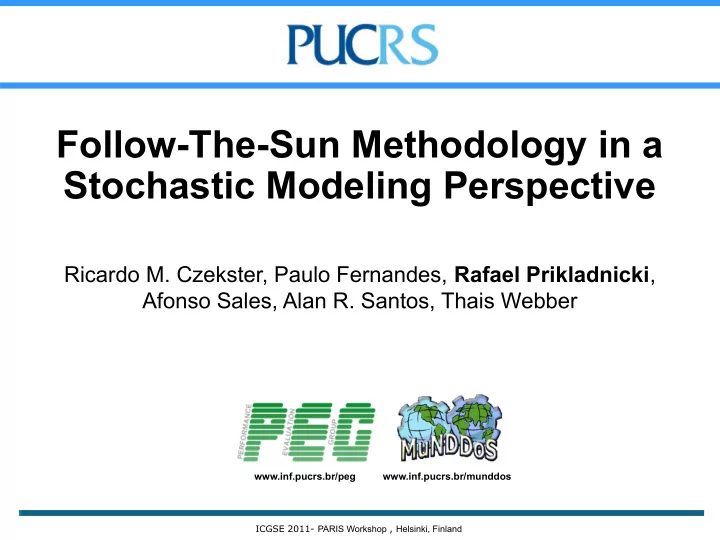

Follow-The-Sun Methodology in a Stochastic Modeling Perspective Ricardo M. Czekster, Paulo Fernandes, Rafael Prikladnicki , Afonso Sales, Alan R. Santos, Thais Webber www.inf.pucrs.br/peg www.inf.pucrs.br/munddos ICGSE 2011- PARIS Workshop , Helsinki, Finland
Research goal Our goal To discuss a formal mapping of Follow-The-Sun characteristics to a stochastic model in order to predict performance indices of teams such as availability Proposal of an initial modeling effort which aims to enhance understanding and feasibility evaluation for FTS projects ICGSE 2011- PARIS Workshop , Helsinki, Finland
Context and motivation There are times when the speed of implementation of a software development project is important and special measures are needed to fast track it without impacting the rest of the project portfolio. Follow-The-Sun (FTS) is being experimented to reduce development phase duration, opening research opportunities in the field of team building, global software development tools, and coordination strategies. We did an initial study for modeling and evaluation of FTS projects Demonstrate the benefits of using the Stochastic Automata Networks (SAN) formalism for the modeling and evaluation of distributed teams Present a model trying to enhance the understanding and feasibility evaluation for FTS projects calculating probabilities for availability and project risk factor, such as hand-off efficiency ICGSE 2011- PARIS Workshop , Helsinki, Finland
Analytical Modeling in FTS projects Target : geographically distributed projects - FTS key factors in FTS: communication and coordination analytical modeling of sites activities and interactions Tool : high-level modeling formalism Stochastic Automata Networks (SAN) [Plateau’85] modular representation (states, transitions, events) suitable for modeling independent entities with synchronizing activities numerical solution using GTAexpress software package [QEST’09] ICGSE 2011- PARIS Workshop , Helsinki, Finland
Follow-The-Sun (3 sites example) ICGSE 2011- PARIS Workshop , Helsinki, Finland
SAN Model ICGSE 2011- PARIS Workshop , Helsinki, Finland
Automaton ICGSE 2011- PARIS Workshop , Helsinki, Finland
SAN Model Events Event Description Average Time open After being off-line for (in average) 16 hours, a site 16h initiates the hand-off opening process. wk A site spends in average 1 hour in the beginning of 1h the workday performing the hand-off opening process. rw A site works in average 1 hour per workday before 1h reworking a pending issue. nt A site remains reworking a task in average 0.5 hour 0.5h before starting a new task. cl_wk Before starting the hand-off closing process, a site 4h remains working in average 4 hours per workday. cl_rw Before going to a hand-off closing process, a site 0.5h stays in average 0.5 hour reworking a task. off A site spends in average 1 hour in the 1h end of the workday executing the handoff closing process. ICGSE 2011- PARIS Workshop , Helsinki, Finland
Steady-State probabilities (entities) Falar do Resultado e o porque o modelo ainda não esta pronto, como pode ser visto no gráfico, se possível já falar aqui de uma solução para o modelo. ICGSE 2011- PARIS Workshop , Helsinki, Finland
Possible scenarios configurations (example) Scenario Quality Level Quality Level Quality Level Site 1(event wk) Site 2(event wk) Site 3(event wk) 1 High High High 2 High High Medium 3 High High Low 4 High Medium Medium 5 High Medium Low 6 High Low Low 7 Medium Medium Medium 8 Medium Medium Low 9 Medium Low Low 10 Low Low Low *varying parameters to predict other behaviors, it is possible to be done for each model event ICGSE 2011- PARIS Workshop , Helsinki, Finland
Final Remarks Limitations to capture other important follow-the-sun dimensions such as increase the number of sites, synchronous hand-off, geographic distance, communication patterns and teams coordination. Conclusions and future work theoretical modeling effort to describe a complex environment analytical modeling is useful to predict behaviors before implementing a project or process once improved the model can provide new quantitative measures only changing model parameters focus on software development processes such as flow of requirements engineering, development and testing, project schedule evolution, etc. ICGSE 2011- PARIS Workshop , Helsinki, Finland
The Methodology This is part of a research program State of the art review on software 2011/1 development using follow-the-sun and Stochastic Modeling Quantitative study Stochastic Model creation and execution to 2011/1 collect numerical results from simulation using different scenarios to see FTS model behavior ICGSE 2011- PARIS Workshop , Helsinki, Finland
Recommend
More recommend